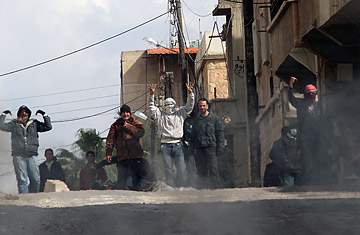
Anti-government protesters gesture on the streets of Daraa, 100kms south of the capital Damascus on March 23, 2011.
Syria's closed authoritarian political system makes it difficult to know exactly what's going on beneath the society's surface, even in the best of times. And this is not the best of times, as security forces move to violently quash protests in the southern city of Dara'a and other areas. But this much is clear, regardless of whether you choose to believe the Ba'athist regime or its many foes: Events in Dara'a and elsewhere have escalated dangerously beyond the comfort zone of the regime of President Bashar al-Assad, and as many as six people have reportedly been killed in clashes around Al-Omari Mosque on Wednesday.
State-run television put the death toll at four, and blamed "armed gangs" for the unrest. It broadcast footage of weapons and ammunition it said security forces had retrieved from inside the mosque. The official SANA news agency reported that the "gangs" attacked an ambulance, killing the driver and a nearby policeman, as well as a doctor and a paramedic in the vehicle.
Several dissident websites, however, offered a very different version of events: The security forces had stormed the house of worship and emptied it, they said, after anti-government protesters took refuge in and around the mosque. Six people were killed and 230 wounded, they said. Several short snippets of amateur video, each about three minutes long and purportedly filmed in Dara'a early Wednesday, center on the street in front of the mosque and what appears to be a line of security forces. Gunshots ring out. A young man, speaking with the drawn-out drawl of Syrian Arabic, screams "traitors, you traitors" and "who kills their own people? How can you kill your own people? You are our brothers!" The authenticity of the shaky footage is impossible to verify, especially given that the same dissident websites, as well as several mainstream news sources, claim that electricity was cut to Dara'a whereas the streetlights are still clearly working in the videos.
What is also clear, is that the unprecedented, almost weeklong outpouring of public fury in this outlying region bordered by Jordan is the most serious challenge to President Bashar al-Assad's iron-fisted rule since he inherited the reins from his late father Hafiz in 2000.
Assad has moved quickly to quell the unrest, dismissing the local governor for overreacting to the cause of the unrest — the detention of 15 schoolchildren for scribbling anti-government graffiti around town. The youths, all younger than 17, have since been released, but tensions remain high, even after Assad dispatched a high-level delegation to offer his condolences for several deaths in the city, and promised to hold to account those responsible.
But it looks increasingly like many Syrians, and especially the residents of Dara'a, are unlikely to be assuaged by more presidential promises. If so, Assad could face a nationwide revolt. Demonstrations have also recently been held in several other cities despite the fact that Syria's 48-year-old emergency law prohibits unlicensed public gatherings. Protesters in Dara'a have called for mass demonstrations across the country on Friday. The response to that call by citizens and the security forces could be key to determining if Dara'a remains a brief outburst or becomes the spark for a more protracted challenge to 41 years of Assad family rule.
The regime's tactics in response to the protest has been a combination of conciliatory gestures and traditional authoritarian tactics, such as arresting former political prisoner and prominent rights activist Loay Hussein from his home near Damascus on Tuesday, after Hussein pledged support for Dara'a's protesters.
Between 3,500 and 5,000 soldiers and secret policemen are now deployed in Dara'a, according to two different dissident websites. Both say that the tribal territory is in lockdown, and that a curfew has been put in place. It's a dangerous development. The last time there were public revolts in Syria — in 2004 by ethnic Kurds in the northern area of Qamishli, and in 1982 by the Muslim Brotherhood in Hama — the protests were ruthlessly crushed. The question, now, is whether Assad will stick to the regime's traditional playbook that bathes dissent in blood, or allow its people to begin writing their own history as Tunisians and Egyptians have done. We may know the answer on Friday.
